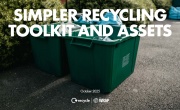Sector calls for five per cent EPR fee allocation to drive reuse
Packaging industry experts at the Global Reuse Summit call for the UK to follow the French model by allocating EPR fees to reuse systems development.
 Experts across the packaging value chain have urged the UK government to follow France’s lead by committing five per cent of Extended Producer Responsibility (EPR) fees to fund reuse infrastructure and communications.
Experts across the packaging value chain have urged the UK government to follow France’s lead by committing five per cent of Extended Producer Responsibility (EPR) fees to fund reuse infrastructure and communications.
The call came during the second Global Reuse Summit, which brought together more than 950 participants from 15 countries to address how the UK can accelerate the transition to reusable packaging systems.
“Today’s summit demonstrates that businesses are committed individually, and in collaboration with others, to bring reuse a step closer,” said Jane Martin, CEO of City to Sea, which organised the event in partnership with Ecosurety. “In every single discussion the case was made for policy makers to support industry with clear and timely legislation supporting reuse.”
A briefing paper, Global Insights on Packaging Reuse for the UK, prepared by Eunomia for City to Sea and launched at the summit, highlighted how earmarking a proportion of EPR income had unlocked €100 million for reuse projects in France in 2024 alone.
Policy framework needed to support reuse
James Bull, Head of Packaging at Tesco, told delegates that while retailers are willing to explore reusable packaging systems, the current market structure favours single-use options.
“It won’t succeed if a customer has to turn left into Tesco and do version A, turn right into the next retailer and do version B, and so on. It gets too confused and too muddled,” Bull said.
He highlighted the need for cross-industry collaboration and standardisation, noting that the Loop/Tesco trial provided valuable insights but ultimately demonstrated the limitations of isolated initiatives.
Bull added: “To get to scale, to get to something that had a business case where it could break even or do better than that, you needed others to be involved. You needed other retailers.”
However, he rejected the notion that businesses seek competitive advantage in this area: “I struggled to find first mover advantage in the sustainability agenda, unfortunately. So it certainly wasn’t about first move advantage. It was about a signal to the marketplace.”
The need for clear policy direction emerged as a key theme. Bull described the current regulatory environment as a “saturated marketplace” with “so many moving parts” and “administrative burdens that are actually distracting from the north star of truly driving change.”
Catherine Conway, Founder of GoUnpackaged, reminded delegates that the government has successfully invested in waste management infrastructure before, pointing to the rollout of kerbside recycling which significantly improved national recycling rates.
Celia Rennesson of Réseau Vrac et Réemploi shared France’s experience, where the development of reuse has been powered by allocating five per cent of EPR fees towards infrastructure and communications to support the transition.
The French model was highlighted in the Eunomia report as an example the UK should follow, with the paper noting this approach “is a clear opportunity to unlock funding for widespread implementation.”
Green Party Peer Baroness Natalie Bennett said the event had ‘united policymakers, businesses, and packaging experts to show just how achievable a transition to reuse and refill is for consumers and retailers. Not only does this cut the flow of plastic, but opens up opportunities for an innovative packaging sector, creating better quality jobs, cutting pollution, and protecting human health.’
She added: “Single-use plastic has choked our environment, our bodies, and our water. At present, many of the chemicals in plastic have not been identified, meaning people are gambling with their health every time they come into contact with plastic. From our cookware to clothes, plastic really is synonymous with everyday life.’
“What’s worse is our waste management system is designed for recycling, which continues to harm people and planet with the release of further toxic chemicals. With only nine percent of all plastic ever produced being recycled, it is evident change is needed.”
Polling conducted by City to Sea in February 2025 found 75 per cent of UK consumers believe reusable packaging must replace single-use packaging to tackle plastic waste.
Sarah Ottaway, Sustainability and Social Value Lead at Suez Recycling and Recovery UK, emphasised the potential role of the waste sector in reuse systems: “The waste sector, other than Royal Mail, it’s probably the only sector that goes to every household every week. So there’s a huge efficiency in there, and all the skills and knowledge and expertise that we have that come with that too.”
Amy Hooper, Innovation Manager at Biffa, noted that reuse projects like reposit are shifting from viewing pilots in isolation to developing city-wide systems that create the necessary scale for commercial viability.
Materials debate
The summit also featured discussion on materials suitable for reusable packaging, with Dr Jane Muncke of the Food Packaging Forum highlighting health concerns around chemical migration.
“In total, there are more than 15,000 different chemicals which are known to be present in food contact materials. So that’s plastic, but also varnishes, coating on metal packaging. It’s in paper,” Muncke said.
Jamie Riley, Sustainability & Circular Economy Manager at Berry Global, suggested beginning with food service items: “Things like coffee cups, hot beverages, food on the go products, those are kind of the low hanging fruit to get people into the mindset.”
Transition timeline
On the question of how quickly reuse systems could be scaled, Bull estimated a five to ten-year horizon: “I think it needs to be phased but I’m in the five to ten year sort of horizon for this to truly get to the scale when we talk 30 per cent. 30 per cent might be six, seven years away.”
The Eunomia report noted that UNESDA estimated transitioning to a reuse model for the soft drinks sector would cost €18.7 billion to achieve 20 per cent reusable PET bottles in the EU by 2030.
“Setting targets without a clear implementation plan can cause confusion, and potentially dilute or even negate the potential environmental benefits,” the report warned. “We don’t just need reuse systems – we need good reuse systems.”
Call to action
Lowelle Bryan, Senior Specialist at WRAP, pointed to the need for standardised measurement: “Standardisation and measurement [are important], because it’s very difficult to demonstrate impact if we’re not actually measuring in the same way.”
Will Ghali, CEO of Ecosurety, concluded: “We were delighted to team up with City to Sea for the second Global Reuse Summit which showed the appetite is clearly there from stakeholders to make reuse a success. Alongside the strong support from industry players, we have the technology to back it up. What we need now is coordinated action from policymakers, businesses and consumers to create the scale needed for these systems to thrive.”
In addition to the allocation of EPR fees for reuse infrastructure, the Eunomia report identified several other “key requirements for a successful transition” including mandatory sector and product-specific targets for reuse and refill, industry technical standards, pooled systems with shared assets and logistics, take-back requirements for retailers, and targeted consumer engagement.
The Global Reuse Summit was hosted by environmental charity City to Sea in partnership with Ecosurety at the We The Curious venue in Bristol.









